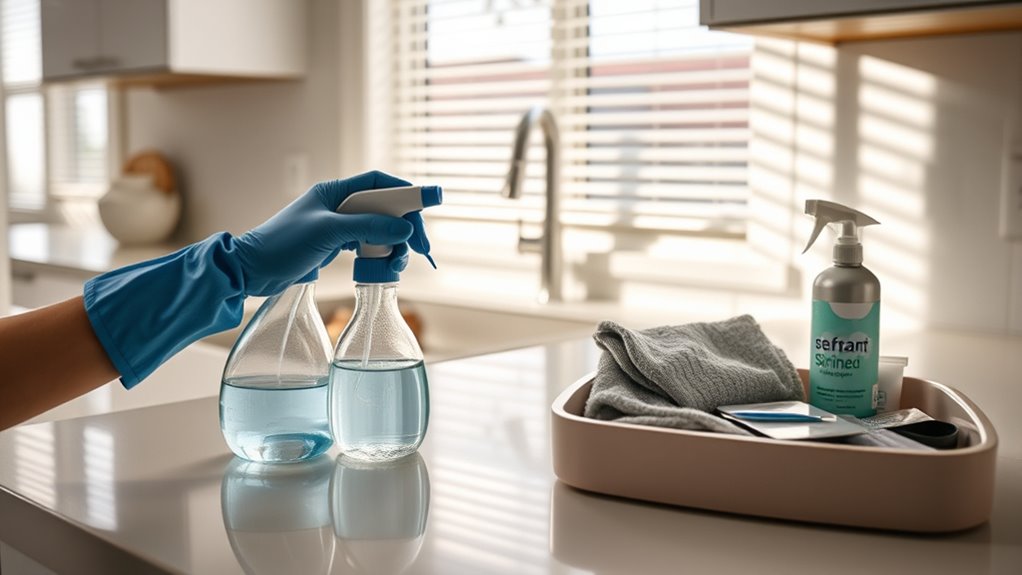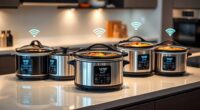During flu season, you should regularly clean and disinfect high-touch surfaces like countertops, switches, and remote controls with EPA-approved disinfectants. Wash your hands often with soap and water for at least 20 seconds or use hand sanitizer with at least 60% alcohol. Improve indoor airflow by opening windows or using HEPA air purifiers. Encourage cover-your-mouth protocols and avoid sharing personal items. Staying consistent with these steps can greatly reduce germs, and you’ll discover more effective strategies as you continue.
Key Takeaways
- Practice thorough handwashing with soap and water for at least 20 seconds, especially after touching common surfaces.
- Disinfect high-touch surfaces daily using EPA-approved disinfectants, focusing on remote controls, switches, and counters.
- Improve indoor air quality by opening windows, using exhaust fans, and deploying HEPA air purifiers to reduce airborne germs.
- Encourage covering coughs and sneezes with tissues or elbows, disposing of tissues immediately, and avoiding sharing personal items.
- Educate household members on hygiene practices and maintain consistent sanitizing routines to prevent flu transmission.

As flu season approaches, maintaining a clean and sanitized home becomes vital to reduce the spread of germs. One of the biggest threats during this time is airborne pathogens, which can linger in the air and settle on surfaces, increasing the risk of infection. To combat this, you need to focus on effective cleaning practices and prioritize hand hygiene, which is your first line of defense. Proper hand hygiene isn’t just about washing your hands; it’s about doing it thoroughly and frequently, especially after touching common surfaces like doorknobs, light switches, or electronic devices. Use soap and water for at least 20 seconds, making sure to scrub all parts of your hands, including under your nails. If soap and water aren’t available, an alcohol-based hand sanitizer with at least 60% alcohol is a quick alternative. Keep hand sanitizer readily accessible throughout your home, especially in high-traffic areas, to encourage regular use. By maintaining good hand hygiene, you markedly reduce the chance of transferring airborne pathogens from surfaces or other people to yourself.
In addition to personal hygiene, cleaning surfaces is vital. Disinfect high-touch areas daily with EPA-approved disinfectants that can effectively kill airborne pathogens and other germs. Pay special attention to frequently used items like remote controls, kitchen counters, bathroom fixtures, and light switches. These surfaces are often overlooked but can harbor germs that become airborne when disturbed. Use microfiber cloths, which trap germs more efficiently than regular cloths, and wash them regularly. Always follow the manufacturer’s instructions for disinfectant contact time to make sure germs are killed. Ventilation also plays a key role in minimizing airborne pathogens. Open windows when possible, and use exhaust fans to improve airflow, helping to disperse any airborne germs and reduce their concentration indoors. Additionally, consider using air purifiers with HEPA filters, which are highly effective at capturing airborne particles, including germs, further reducing the risk of infection.
You should also consider implementing regular sanitizing routines, especially if someone in your home shows symptoms of illness. Encourage everyone to cover their mouth and nose with a tissue or elbow when coughing or sneezing, and dispose of tissues immediately. Avoid sharing personal items like towels, utensils, or electronic devices during flu season. Educating everyone in your household about the importance of hand hygiene and surface cleaning creates a safer environment for all. Remember, maintaining a sanitized home isn’t a one-time effort; it’s a continuous process that helps considerably lower your risk of infection by airborne pathogens. When you stay consistent with these protocols, you’re actively protecting yourself and your loved ones from the spread of germs, making your home a safer haven during flu season.
Frequently Asked Questions
Can I Use Natural Disinfectants During Flu Season?
Yes, you can use natural alternatives during flu season, but be aware of their disinfectant effectiveness. Vinegar, tea tree oil, and hydrogen peroxide are common natural options, but they may not kill all flu viruses as effectively as commercial disinfectants. To guarantee safety, use these natural disinfectants properly and combine them with thorough cleaning. For high-risk areas, consider using proven disinfectants to better protect your home.
How Often Should High-Touch Surfaces Be Sanitized?
You should sanitize high-touch surfaces at least daily, as studies show these areas can harbor germs for hours. Regular cleaning reduces the risk of flu transmission. Remember, hand hygiene and personal protection are your best defenses. After touching door handles, light switches, or remote controls, wash your hands thoroughly. Keeping up with this routine helps protect you and your family throughout flu season.
Are Air Purifiers Effective Against Flu Viruses?
Air purifiers can be effective against flu viruses if they have proper virus filtration efficiency, such as HEPA filters. Don’t fall for air purifier myths that claim they eliminate all germs; they’re not a sole solution. Instead, use them alongside regular cleaning and sanitizing. Choose models with proven virus filtration efficiency, and verify proper placement and maintenance for maximum effectiveness in reducing airborne flu viruses in your home.
Should I Disinfect Electronics Regularly?
You should definitely disinfect your electronics regularly—after all, your phone probably hosts more germs than a public restroom. Think of electronics maintenance as a mini spa day for your devices, with UV sterilization acting as their personal germ-killing therapist. Regular cleaning prevents virus buildup, ensuring your gadgets stay virus-free and functioning smoothly. So, give your electronics some love—they deserve it, especially during flu season!
What Are the Best Practices for Laundry During Flu Season?
During flu season, you should follow thorough laundry routines to maintain clothing hygiene. Wash bed linens, towels, and frequently worn clothes in hot water with disinfectant if possible. Dry items completely to prevent germs from lingering. Avoid re-wearing clothing without washing, and regularly clean laundry hampers. These practices help reduce virus spread and keep your home safer. Consistent laundry routines are key to protecting yourself and your family from the flu.
Conclusion
By following these sanitizing protocols, you’re tending your home like a garden, nurturing a sanctuary where health can thrive. Each disinfected surface becomes a shield, a silent guardian guarding against unseen threats. As you clear away germs, you’re planting seeds of liveliness and resilience. Remember, your efforts are the roots that strengthen your household’s foundation, ensuring that when flu season arrives, your home stands resilient—an enduring symbol of care and protection in a world of uncertainties.










